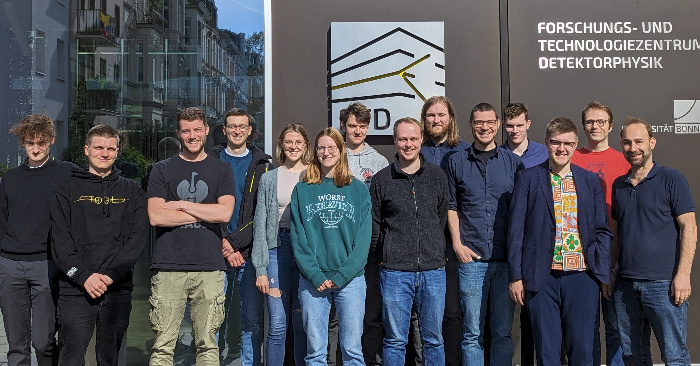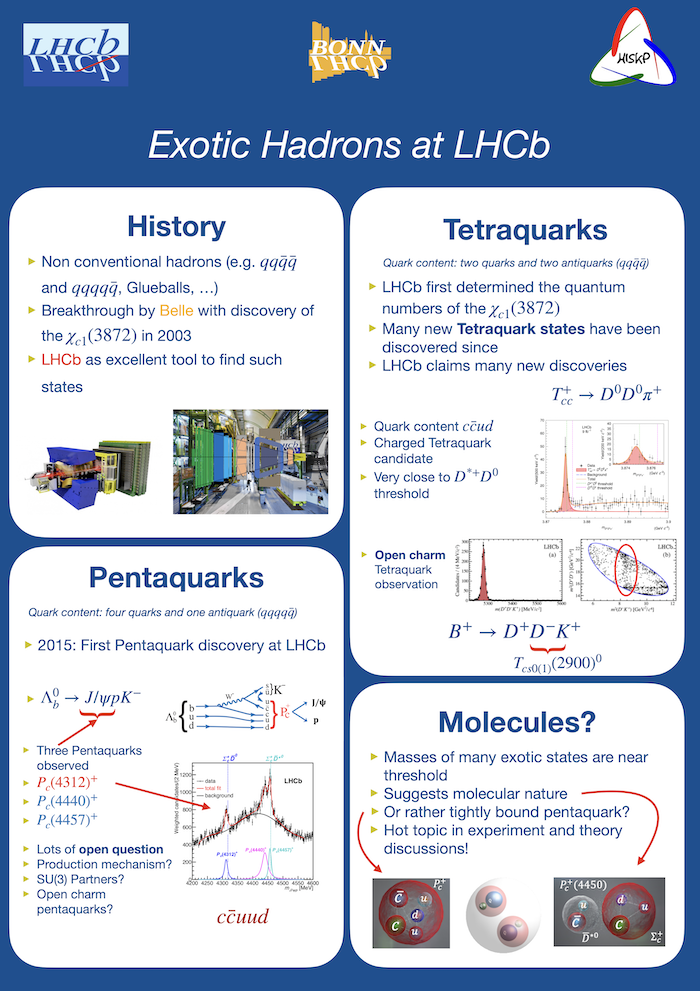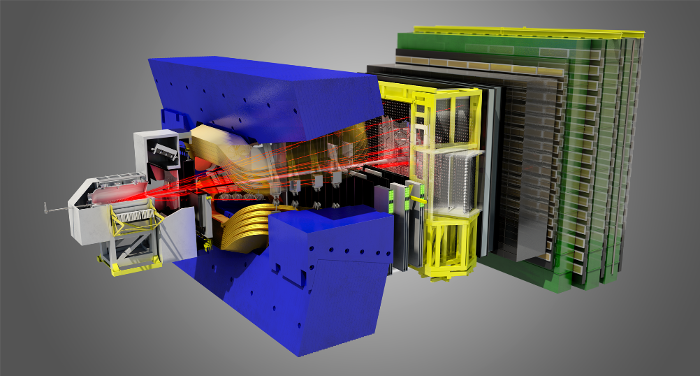LHCb Bonn

We are always looking for motivated students to join our team!
Below is a summary of our primary research focus. Please feel free to contact us to discuss potential projects. If you have ideas of your own that fit our research, we’d be happy to explore your proposal.
We are committed to creating a respectful and inclusive research environment, where everyone feels valued and supported. Therefore, we do not tolerate harassment and discrimination in any form.
The LHCb Bonn group is organized into two teams: Analysis & Software and Hardware.
Software & Analysis
Members: Elli, Kai, Piet
In our analysis projects, our main focus is on exotic hadronic resonances. The LHCb detector provides an excellent laboratory to discover and investigate these states, helping us to deepen our understanding of QCD. From Tetraquarks to Sexaquarks we cover a wide range of analysis topics and methods exploring the nature of such exotic states. This includes dark matter searches, (exotic) hadron spectroscopy and searches for new decay channels of heavy hadrons. We specialize in amplitude analyses and offer opportunities to employ several statistical and machine learning techniques.
With the start of Run 3 of the Large Hadron Collider (LHC) it is an excellent time to join our group and work on hadron physics analyzing the latest LHCb data!
Furthermore, we are involved in developing software for LHCb Data Processing and Analysis (DPA). This requires collaborative work with people based around the world. Our core topics are offline data processing and LHCb Open Data & Analysis Preservation.
Hardware
Members: Hannah, Henry, Klaas, Niclas
Hello and welcome to the LHCb Bonn hardware group at FTD!
We are focusing on the Mighty-Pixel - the pixel detector part of the Mighty-Tracker. For Upgrade || of the LHCb experiment the Mighty-Tracker is foreseen as the upgrade of the downstream tracking system.
Its installation is planned for long shutdown four of the LHC.
But why do we need the Mighty-Tracker?
Good question! Due to an increased instantaneous luminosity the detector has to withstand about 10 times the current hit occupancy and radiation damage. The currently installed scintillating fiber detector could not cope with the maximum hit rate. Therefore, an upgrade is needed. As a cost-efficient solution ensuring and further pushing the current physics performance a hybrid detector consisting of a pixel part in the central region around the beampipe and a scintillating fibers detector in the outer parts is planned.
And how does the Mighty-Tracker look like?
Its shape is driven by the hit occupancy which itself is determined by the LHCb dipole magnet and therefore not spherical around the beampipe but shaped like a horizontal cat's eye. Three tracking stations will be equipped with two layers of silicon each - resulting in six layers in total. Per layer 1.3m² of silicon pixels are foreseen.
And how can the Mighty-Pixel cope with the high occupancy and radiation damage?
For that the foreseen technology are HV-MAPS which combine high granularity, radiation tolerance, efficient charge collection, a low material budget and power consumption. A dedicated sensor, called MightyPix, has been designed for the experiment.
How do you ensure that the MightyPix sensor fulfills the requirements?
We cannot ensure this without proving it. Therefore, an intense R&D phase among various institutes is ongoing. In Bonn we are actively taking part!
What are you doing and what can be done?
Our main focus is on radiation tolerance studies of HV-MAPS using the in-house available facilities as the Bonn cyclotron and a x-ray tube at the FTD. Moreover, we plan to take part in the chip-to-flex production needed for the Mighty-Pixel module production. For both topics we are always looking for motivated students.
Are there any requirements to join the group?
No! If you are interested and willing to learn new things, you are very welcome :) Of course our projects are not always straight-forward and problems might be frustrating, but we will try our best to push you through those times such that you get an excellent result. Further, all our topics are very important for the Mighty-Pixel project. Therefore, you will always make a contribution to the project.
If you are not yet interested, we can maybe catch you by our air-conditioned laboratory at the FTD. See you soon!
Outreach
Our group is developing an LHCb Masterclass, with the purpose of bringing hadron physics into schools. At the end of the one day workshop pupils have the opportunity to analyze real LHCb data to find new particles. We want to spark interest in pupils, highlighting key concepts of data analysis in particle physics as well as the collaborative aspects of working in research. We are always looking for motivated students to help us, especially those pursuing a degree in teaching.
Our finished projects and publications are linked on Confluence
Group Members
Prof. Sebastian Neubert
Group leader
Ellinor Eckstein (PhD student)
Sexaquark search at LHCb, LHCb Data Processing, Women* in Physics Bonn organizer
Kai Habermann (PhD student)
Hadron Spectroscopy using amplitude analysis techniques
Piet Nogga (PhD student)
Search for Exotic Hadrons in Semileptonic B decays, LHCb Open Data
Dr. Klaas Padeken
Coordinator of the LHCb Mighty Pixel, HV-CMOS Characterization, Irradiartion studies, DAQ development, Module development
Hannah Schmitz (PhD student)
Development of a readout system for HVCMOS MAPS, Characterization of HVCMOS MAPS for the LHCb Mighty Tracker
Henry Schumacher (PhD student)
Setting up and operating an Ion Beam Analysis experiment at the Bonn cyclotron using RBS and PIXE
Niclas Sommerfeld (PhD student)
A Multisensor Test Setup for the Characterization of HV-CMOS Monolithic Active Pixel Sensors for a Future LHCb Upgrade
The LHCb Experiment at CERN
LHCb is a particle physics experiment at the Large Hadron Collider (LHC) at CERN. The detector system is optimized to detect the decay products of beauty and charm hadrons and idenitfy these long living particles using a precision vertex locator (VELO). LHCb is the only experiment at the LHC, which is equipped with particle identification (PID) subsystems covering the complete fiducial acceptance of the detector. These features make it an ideal instrument to study hadronic resonances, which are produced in the decays of heavy hadrons.
For more information check the LHCb public webpages.

Contact Details
Prof. Dr. Sebastian Neubert
Helmholtz-Institut für Strahlen- und Kernphysik
Raum 2.004
Nussallee 14-16
53115 Bonn
Tel.: 0228/73-2226
Fax.: 0228/73-2505
EMail: neubert(at)hiskp.uni-bonn.de

